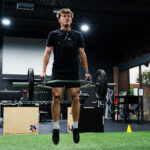Sports Performance Training for Youth Athletes
Youth sports are more competitive than ever. Parents and coaches want young athletes to excel—not just now, but for years to come. That’s why age-appropriate sports performance training is essential.
Training young athletes the right way builds a solid foundation of strength, speed, coordination, and confidence—all while reducing injury risk.
Why Youth Athletes Need Performance Training
Many people assume that kids should only “play” sports and avoid formal training. But structured sports performance training, when done safely and correctly, offers huge benefits:
-
Improves athletic coordination
-
Enhances movement quality and control
-
Develops speed, agility, and strength
-
Reduces risk of overuse injuries
-
Builds confidence and discipline
The key is to focus on development over competition.
What Makes Youth Training Different?
Youth athletes are still growing—physically, mentally, and emotionally. Training programs must reflect their unique needs:
-
Body awareness comes before heavy lifting
-
Movement variety is more important than sport-specific drills
-
Proper technique matters more than intensity
-
Fun and engagement drive long-term commitment
The focus should be on developing well-rounded athletes, not peaking too soon.
Best Practices for Training Youth Athletes
Follow these science-backed guidelines to design safe, effective youth programs:
1. Prioritize Fundamental Movement Skills
Start with basic patterns that develop balance, mobility, and coordination:
-
Squatting
-
Lunging
-
Jumping and landing
-
Skipping and hopping
-
Crawling and climbing
These skills form the base for all athletic movement.
2. Focus on Bodyweight Strength First
Avoid heavy weights early. Use bodyweight drills to teach control:
-
Push-ups
-
Air squats
-
Step-ups
-
Planks
-
Bear crawls
Once they master form and stability, you can add light resistance with supervision.
3. Train Speed and Agility Often
Young athletes are naturally fast learners. Short, fun drills improve their coordination and explosiveness:
-
Cone sprints
-
Ladder drills
-
Direction-change games
-
Relay races
Keep drills short and engaging to hold their attention.
4. Include Core and Stability Work
A strong core supports all other movement and reduces injury risk:
-
Dead bugs
-
Side planks
-
Balance drills on one leg
-
Medicine ball tosses (light weight)
Train control and balance before adding power.
5. Make It Fun
The best youth programs feel like games. Use challenges, partner drills, and variety to keep things exciting. The more fun they have, the more they’ll want to keep training.
Sample Weekly Youth Training Plan
Here’s a simple layout for a beginner-level youth athlete (ages 9–13):
| Day | Focus |
|---|---|
| Monday | Speed + Agility + Fun Games |
| Wednesday | Full Body Strength + Core |
| Friday | Agility + Balance + Mobility |
Each session should be 45–60 minutes and include a warm-up and cooldown.
Top 5 Exercises for Youth Athletes
1. Skater Jumps
Why: Build lateral strength and balance.
How: Hop side to side on one leg, landing with control each time.
2. Bear Crawls
Why: Strengthen full-body coordination.
How: Crawl on hands and feet, keeping knees off the ground and hips low.
3. Wall Sits
Why: Build leg endurance and control.
How: Sit against a wall with knees at 90 degrees. Hold for 20–30 seconds.
4. Ladder Quick Steps
Why: Improve foot speed and rhythm.
How: Step through an agility ladder with fast, light feet.
5. Medicine Ball Chest Passes
Why: Develop upper body power.
How: Pass a light medicine ball (4–6 lbs) to a partner using both hands.
What to Avoid in Youth Training
Protect youth athletes by avoiding common mistakes:
-
Avoid max lifts or heavy weights before puberty
-
Avoid burnout from early specialization in one sport
-
Avoid punishing workouts—focus on learning, not fatigue
-
Avoid long-distance running—sprints are better for development
-
Avoid comparison—each child develops at their own pace
Safety, fun, and progress should always be the priority.
Role of Recovery and Nutrition
Even young athletes need proper rest and fuel:
-
Sleep: Aim for 9–11 hours per night
-
Hydration: Encourage water before, during, and after activity
-
Nutrition: Focus on fruits, veggies, whole grains, and lean protein
-
Rest days: Allow 1–2 full days off per week from intense activity
Recovery habits formed early will last a lifetime.
The Long-Term Athlete Development (LTAD) Model
Experts like the NSCA recommend a gradual, long-term approach to training. LTAD stages include:
-
Active Start (under age 6): Play-based movement
-
FUNdamentals (ages 6–9): Basic movement skills
-
Learn to Train (ages 9–12): General athletic development
-
Train to Train (ages 12–16): Structured strength and sport prep
-
Train to Compete (16+): Specific performance goals
Your child doesn’t need to be a star by age 10—focus on steady growth.
Get Expert Guidance
To ensure proper form and age-appropriate workouts, consider working with a certified performance coach. Organizations like Next Level Athletics specialize in youth development programs that balance fun and athletic progress.
Their programs help kids build confidence while developing speed, strength, and coordination.
Conclusion: Invest in the Future
Youth athletes need smart, balanced training—not just more practice. The right sports performance training builds a strong athletic foundation, reduces injury risk, and encourages long-term success.
Start early, focus on fundamentals, and keep it fun—and you’ll raise a healthy, confident athlete who loves to compete.


Recent Comments